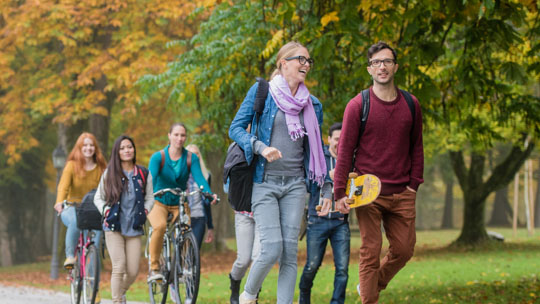What it's Like to Study Abroad in Buenos Aires According to Students
Sponsored by the City of Buenos Aires
The Argentine capital of Buenos Aires, perched on the shore of the Rio de la Plata on the south-eastern coast of Latin America, is one of the most diverse and beautiful cities in Latin America.
Home to a rich tapestry of cultural influences, the city has received with open arms millions of immigrants for over a century from Italy, Spain, China, Germany, France and beyond.
But what’s it actually like for international students based here? 61,100 of them arrived here in 2017 alone, so we tracked down a few of the city’s international students to find out what they think of life in the best city for students in the Spanish-speaking world, according to the QS Best Student Cities 2018 ranking.
A strong academic offer
Buenos Aires boasts some 40 universities, nine of which are internationally ranked, including the Universidad de Buenos Aires, Universidad Austral, Universidad de Belgrano, Universidad de Palermo, Universidad Torcuato Di Tella, and Pontificia Universidad Católica Argentina Santa María de los Buenos Aires.
Universidad de Buenos Aires, for instance, was ranked 73rd in the QS World University Rankings 2019, making it the best university in Ibero-America. This Argentine university is one of the largest and most prestigious institutions in the world and has seen some of the world’s brightest and talented minds, including four Nobel Prize winners and several presidents.
Sarah Achar moved here from Mexico City precisely for the city’s incredible academic offer.
She says: “I’m here for a mixture of reasons. For a long time, I wanted to study at a university as good as the University of Buenos Aires.”
New sources of inspiration at every turn
The birthplace of tango, with its French and Italian influences, its colorful houses and its beautiful street art, has a way of getting under your skin.
Stephanie Bevilacua knows how it feels to be captivated by the city all too well, and she says she can’t help telling her friends back home how inspiring Buenos Aires can be.
After arriving in the city, Stephanie worked selling tours of Caminito (a famous street in Buenos Aires that inspired the tango song "Caminito"). She describes how she was fascinated by a local woman who would grab tourists and help them feel like tango dancers, posing for pictures that went some way to capturing the passion of the tango. Stephanie eventually approached the woman herself and suggested shooting a documentary with her as the protagonist.
She says: “I’ve always liked Argentine cinema, and I think there are a lot of opportunities in film and culture. That’s why I thought it would be good to come here.
An unmissable nightlife
From dusk until dawn virtually every day of the week, the Argentine capital’s craft breweries, clubs and cocktail bars are thronged with porteños (local residents) and tourists eating and dancing.
Nick Fritz, 23, from Minneapolis in the US, is studying Spanish here. He describes himself as somewhat of a nighthawk and says he knows how exhilarating Buenos Aires can be at night.
“I love the city. I love the architecture, the buildings, the food. I love the nightlife - in Buenos Aires it’s very different than my home state,” he says. He goes on to talk excitedly about how the city stays full of life and energy into the early hours, with meal times and bar closing hours much later than he’s used to back home. It’s this difference in lifestyle which has seen him fall in love with the Argentine capital.
He’s not alone in feeling this way. Kevin Picca, 25, moved to the city from Aix-en-Provence in France two years ago. After applying for a work permit, he’s now working in event management in the gastronomy industry and says one of his favorite things about the city is how he only needs a bicycle to get around.
He adds: “I also like the city’s gastronomy. There’s a wide range of restaurants and culinary events, and it’s always interesting to discover new restaurants with friends.”
A phenomenal work-life balance and quality of life
It shouldn’t come as a huge surprise that Numbeo ranks the quality of life in the Argentine capital highly, praising its affordability, climate and very high standard of healthcare in particular.
Another contributor to the city’s feel-good factor, it’s fair to say, is that the residents of Buenos Aires have truly mastered the balance of work and personal life.
Juan Campoamor, from Barcelona, divides his time between work, university and making music. He shares an apartment with a friend and works shifts a Swiss restaurant in San Telmo Market while pursuing a master’s in social policy.
Juan says: “During my free time, I play guitar with my roommate Jordi, a bit of rumba, a bit of flamenco, and we spend our days working, studying, playing guitar and going out.
“The academic offer [in Buenos Aires] is very attractive and the food is good, which are two things which are important to me. You soon find your space here”.
Sarah agrees, highlighting the wide range of free exhibitions, concerts and theaters in the city. This wide range of cultural delights means you’ll definitely find something for you here.
A warm atmosphere with an incredible football culture
Buenos Aires is very much known for its warm and welcoming atmosphere and its amazing culture of hospitality. Its warmth is one of Alice Bourassin’s favorite things about living here.
Alice, 22, from France, spent a semester in the city while she was pursuing a bachelor’s degree in international business. She now works as a project manager at EIDOS, an innovative education foundation based in Buenos Aires, creating content for their website and managing their social networks.
Alice says: “Really, what I like the most about the city is the human atmosphere. Everyone is very warm and friendly and keen to know a bit about others.”
Daniel Schӓffer, 26, from Germany, shares Alice’s views on Argentine hospitality. He got to experience life in the Argentine capital while studying here as part of a double-degree program, which saw him split his studies across two countries.
He says: “What I like most are the porteños. They’re very open and friendly.”
However, Daniel’s second favorite thing about living in Buenos Aires is its incredible football culture.
“Another thing I like a lot is that there are lots of opportunities for sport. You can play a lot of soccer. The Argentines really love football. You can really feel the Latin American atmosphere here.
“You simply have to come and experience it for yourself. I can say many things but there’s nothing like experiencing it with your own eyes.”
Join Daniel, Alice, Juan, Nick, Stephanie and Sarah in Buenos Aires
Wondering what life in the Argentine capital would be like? Here's how some students got on studying and living in Buenos Aires.



